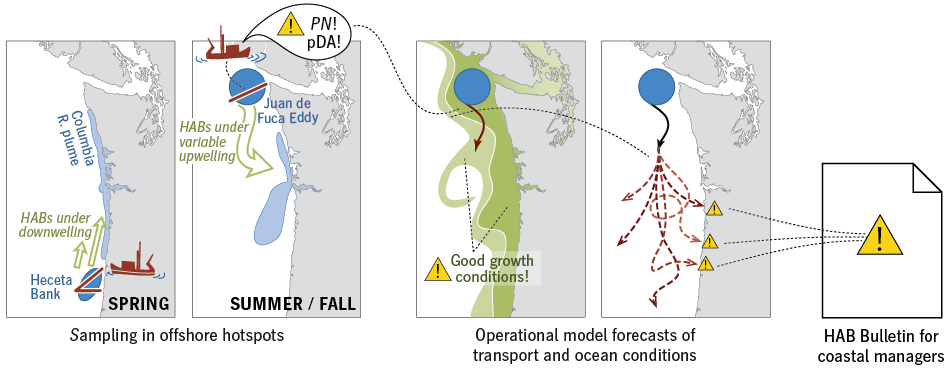Certain species of the phytoplankton Pseudo-nitzschia (PN) produce a potent neurotoxin, domoic acid (DA), that bioaccumulates in shellfish, and can cause severe illness and death in humans. Past outbreaks have caused fisheries closures and millions of dollars of losses to crab and clam harvesters, and contributed to the death of many species of marine mammals. I’m the co-lead of a partnership among US and UK academics and federal, state, and tribal scientists in the US Pacific Northwest that has implemented an early-warning system, the “Pacific Northwest Harmful Algal Bloom Bulletin,” that helps government resource managers protect health and livelihoods.
A new PhD project at Strathclyde (Paul Odum, starting in Jan 2019) aims to improve the precision and mechanistic detail of the spatial analyses and simulations that go into the production of that Bulletin. The arrival of a PN harmful algal bloom (HAB) on a Pacific Northwest beach is the result of a chain of physical and biological ocean processes: i) the buildup of PN species relative to other phytoplankton in one of a few known offshore hotspots; ii) transport by wind-driven ocean currents from those hotspots to the beaches; and iii) the maintenance of the PN cell population and their toxin levels during transport. Currently, the HAB Bulletin makes use of the high-resolution LiveOcean model in addition to a variety of direct observations, but the predictive skill of the forecast relies on the physics of the transport step (ii), not the biology (i,iii). This is the area for potential improvement that Paul’s studentship targets: adding the ability to predict PN population dynamics and DA production, by a combination of statistical and mechanistic/first-principles approaches.
This work is supported by the NOAA MERHAB program, in partnership with NANOOS (Northwest Association of Networked Ocean Observing Systems), ORHAB (Olympic Region Harmful Algal Blooms), the Washington Department of Health, the Washington Department of Fish and Wildlife, and the Makah Tribe.
